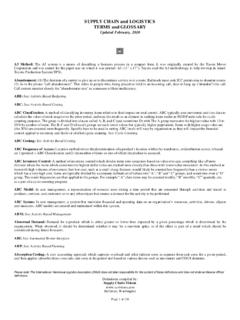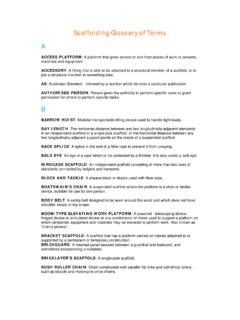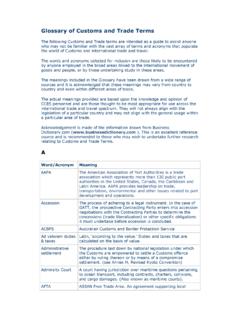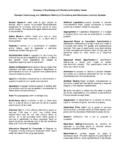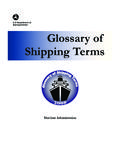Transcription of Glossary of Compensation Terms
1 Glossaryof Department of LaborAlexis M. Herman, SecretaryBureau of labor StatisticsKatharine G. Abraham, CommissionerAugust 1998 Report 923 Individuals interested in employee Compensation are likely toencounter the Terms listed in this Glossary . Definitions arebrief and may not reflect all usage. Some Terms have a specificlegal meaning, either through legislative enactment or judicialinterpretations, which may differ from the usual who need more precise meanings for these Terms shouldconsult standard textbooks or legal reference materials availableat bookstores and libraries. This Glossary also provides examplesof how some of the Terms are used in National CompensationSurvey publications; the Terms may be used differently in otherBureau of labor statistics bureau s new National Compensation Survey will inte-grate three major programs The Employment Cost Index, theOccupational Compensation Survey program, and the EmployeeBenefits Survey into one comprehensive Compensation programby the end of this decade.
2 The NCS program will produce infor-mation on the Employment Cost Index, employer costs for em-ployee Compensation , occupational wage levels, and the incidenceof and provisions in employee benefit Glossary is based in part on an earlier one, Glossary ofCurrent Industrial Relations and Wage Terms (BLS Bulletin 1438,1965). Richard K. Yeast, an economist in the Division of Com-pensation Data Analysis and Planning, prepared this report. Ken-neth J. Hoffmann, an economist in the same division, assisted inthe preparation. Leon Lunden, formerly with the same division,was the original coordinator of the bureau of labor statistics welcomes comments on theusefulness of the Glossary and the adequacy of its send any comments to the Division of Compensation DataAnalysis and Planning, Room 4175, 2 Massachussetts Ave., NE,Washington, DC 20212. E-mail address: in this publication is available to sensory impairedindividuals.
3 Voice phone: (202) 606-7828; TDD phone: (202)606-6897; TDD message referral phone: 1-800-326-2577. Thisinformation is in the public domain and, with appropriate credit,may be reproduced without DEATH AND DISMEMBERMENT (AD&D)INSURANCEI nsurance that provides payment for accidental loss of life,limb, hearing, or sight. Insurance usually covers both occu-pational and nonoccupational deaths and injuries, but cover-age may be limited to one or the other. Double indemnityprovisions of life insurance plans are considered to be AD&Dif they provide benefits for both accidental death and LEAVE PLANSE mployees earn a specified number of vacation hours or sickleave hours each pay period. For example, new Federal gov-ernment employees earn 4 hours of vacation leave and 4 hoursof sick leave each pay WAGE CHANGEA general wage change affecting all or most employees in aplant, company, or industry, because of a cents-per-hour orpercentage increase or SERVICES ONLY (ASO) PLANAn employees benefit plan that is administered by an insur-ance company or other third party.
4 The employer is entirelyat risk for paying employee ASSISTANCEF inancial aid given to employees for the purpose of coveringall or part of the cost of LEAVEE xcused leave accorded to employees for attending legal pro-ceedings leading to adoption and also, like maternity or pa-ternity leave, for a period of time after adoption of a child.(See Family and Medical Leave Act of 1993 (FMLA).AFL-CIO (AMERICAN FEDERATION OF labor ANDCONGRESS OF INDUSTRIAL ORGANIZATIONS)Federation of over 70 autonomous national and internationalGlossary 1unions created by the merger of the American Federation ofLabor (AFL) and the Congress of Industrial Organizations(CIO) in December 1955. The initials AFL-CIO after thename of a union indicate that the union is an DISCRIMINATION IN EMPLOYMENT ACT OF 1967(ADEA)Federal law prohibiting bias against older workers in hiring,discharge, Compensation , or other Terms , conditions or privi-leges of employment.)
5 Applies to workers aged 40 or olderworking for firms of 20 employees or more. (See Older Work-ers Benefit Protection Act of 1990.)AGENCY SHOP (see Union Security)AGREEMENT (COLLECTIVE BARGAINING AGREE-MENT, UNION CONTRACT)Written contract between an employer (or an association ofemployers) and a union (or unions), usually for a specifiedterm, defining conditions of employment (wages, hours, va-cations, holidays, overtime payments, working conditions,etc.); detailing rights of workers, the union, and management;and describing procedures to be followed in settling disputesor handling issues that arise during the life of the WITH DISABILITIES ACT OF 1990 (ADA)Federal law barring discrimination against qualified individu-als who have disabilities in job application procedures, hir-ing, firing, advancement, Compensation , benefits, job train-ing, and other Terms , conditions and privileges of employ-ment.
6 The law also requires reasonable accommodation tothe employee s disabling condition. Rehabilitation Act (Sec-tion 503)-Bars discrimination and requires reasonable accom-modations by Federal contractors and subcontractors. (SeeEqual Employment Opportunity Commission.)ANNIVERSARY YEAR VACATION PLANTime-based vacation plan offering additional vacation timeto employees on certain anniversary years. For example,2 Glossaryemployees receive an extra week of vacation at 10 or 20 yearsof service (but not during intervening years).ANNUITYA form of distribution from a retirement plan providing peri-odic payments. Straight-life annuities provide payments, usu-ally monthly, for the lifetime of a retiree. Joint-and-survivorannuities provide payments to a retiree, and upon the retiree sdeath, payments to a surviving learner or beginner who enters into a formal agreement toachieve journey-level worker status in a skilled trade.
7 Theagreement requires that the person undergo supervised prac-tical training and experience and receive technical off-the-job or classroom instruction related to the skilled trade, usu-ally for a specified period of RATESS chedule of wage rates applicable to workers formal appren-ticeship training. The rates usually rise gradually until ap-prentices achieve journey-level status and the rates that ac-company journey-level (VOLUNTARY, COMPULSORY, ADVI-SORY)Method of settling labor -management disputes through an im-partial third party, whose decision is usually final and bind-ing. Arbitration is voluntary when both parties agree to sub-mit disputed issues to arbitration, and compulsory if requiredby law. A court order to enforce a voluntary arbitration agree-ment is not usually considered compulsory arbitration. Advi-sory arbitration - As provided in Federal Government agree-ments, arbitration without a final and binding impartial third party to whom disputing parties submittheir differences for decision (award).
8 An ad hoc arbitrator Glossary 3acts in a specific case or a limited group of cases. A perma-nent arbitrator serves for the life of the contract or a stipu-lated term, hearing all disputes that arise during this DIFFERENTIALS (see Wage Differentials)AT RISK PAYPay that an employee is not guaranteed to receive but mayreceive under certain circumstances. Examples include com-missions, piece rates, and various kinds of bonuses such assafety or attendance BONUSP ayment or other type of reward ( , a day off) for employ-ees whose work attendance record meets certain standards.(See Bonus - (Production and Nonproduction).)AUTOMATIC PROGRESSIONP olicy by which workers pay rates are automatically increasedat fixed time intervals. Also refers to automatic movementfrom trainee rate to job classification rate or to the minimumof a rate HOURLY RATERate that is calculated by taking an employee s earnings anddividing by the hours LOADEDM ultiyear collective bargaining contract in which wage oremployee benefit increases or both, are greater in the lateryears of the agreement than in the first year.
9 (See FrontLoaded.)BACK PAYP ayment of part or all of an employee s wages for a particularprior period of time, arising from arbitration, court, or boardawards, grievance settlements, errors in computation of pay,misinterpretation of wage legislation, GlossaryBARGAINING AGENT (BARGAINING REPRESENTATIVE)A union designated by an appropriate government agency,such as the National labor Relations Board, or recognizedvoluntarily by the employer, as the exclusive representativeof all employees in the bargaining unit for purposes of collec-tive RIGHTSL egally recognized right of unions to represent workers indealings with UNITG roup of employees in a craft, department, plant, firm, orindustry recognized by the employer or group of employers,or designated by an authorized agency such as the NationalLabor Relations Board, as appropriate for representation bya union for purposes of collective RATEWage rate for work performed during a unit of time, mostcommonly expressed as a rate per hour.
10 It may, however, beexpressed as an amount per day, week, month, or year. Doesnot include overtime or incentive rates. Under an incentivepay system, base rate may refer to the rate of pay for workthat does not meet an incentive production standard or fordowntime. Sometimes differs from the guaranteed person designated by an employee or retiree to receivebenefit payments in the event of the employee s or retiree REOPENER (see Reopening Clause)BENEFITSN onwage Compensation provided to employees. The NationalCompensation Survey groups benefits into five categories:Paid leave (vacations, holidays, sick leave); supplementary Glossary 5pay (premium pay for overtime and work on holidays andweekends, shift differentials, nonproduction bonuses); retire-ment (defined benefit and defined contribution plans); insur-ance (life insurance, health benefits, short-term disability, andlong-term disability insurance) and legally required benefits(Social Security and Medicare, Federal and State unemploy-ment insurance taxes, and workers Compensation ).










